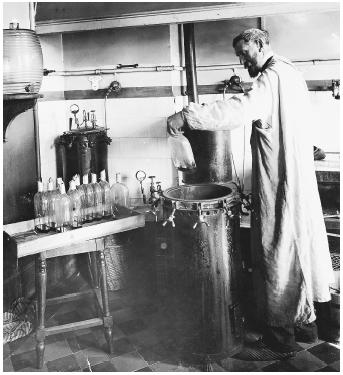 The following is an article from Uncle John's Giant 10th Anniversary Bathroom Reader.
The following is an article from Uncle John's Giant 10th Anniversary Bathroom Reader.Last week, we told you about the battle to end the sale of adulterated milk. Part II is the story of the fight to pasteurize the U.S. milk supply. It's an instructive tale. In spite of proof that pasteurization could save lives, Americans resisted it because it was a new idea... and because it "cost too much."
SOLID PROGRESS
During the latter part of the 19th century, improvements were made in the quality of milk sold in the United States.
Bottles: In 1884, for example, Dr. Hervey G. Thatcher patented the first practical milk bottle with a sealable top. He got the idea while standing in line in the street for his own milk a year earlier. When the little girl ahead of him dropped her filthy rag doll into the milk dealer's open milk can, the dealer just shook the doll off, handed it back to the little girl, then ladled Thatcher's milk as if nothing happened.
Thatcher's bottle wasn't a solution to all of raw milk's problems, but at least it kept impurities out of the milk after it left the dairy. Many dairies hated the bottles because they were expensive and broke relatively easily, but they caught on with the public and were soon in use all over the country.
 The Lactometer: In the early 1890s, New York State began regulating the content of milk using a lactometer, a newly invented device that could measure the amount of milk solids in milk. For the first time, it was possible to compare pure milk with a test sample of a dairy's milk to see if it had been watered down or adulterated. If the milk tested didn't contain the same amount of milk solids as pure milk, the milk dealer could be fined or penalized.
The Lactometer: In the early 1890s, New York State began regulating the content of milk using a lactometer, a newly invented device that could measure the amount of milk solids in milk. For the first time, it was possible to compare pure milk with a test sample of a dairy's milk to see if it had been watered down or adulterated. If the milk tested didn't contain the same amount of milk solids as pure milk, the milk dealer could be fined or penalized.BATTLING BACTERIA
But by far, the most important breakthroughs were scientific. The 1880s and 1890s were a period of great advancement in the understanding of bacteria and its role in causing disease.
In 1882, for example, A German scientist named Rupert Koch discovered that bovine tuberculosis, a form of tuberculosis found in cattle, could be spread to humans through diseased milk. This form of tuberculosis attacked the glands, intestines, and bones, frequently killing the afflicted or leaving them deformed for life.
"Children seem to be especially susceptible to bovine tuberculosis," James Cross Gilbin writes in Milk: The Fight for Purity. "[Victims] often spent years trapped into spinal frames...designed to prevent deformity while the body slowly overcame the infection."
Researchers discovered other diseases could be spread by milk as well. They found that if a cows udders weren't cleaned before milking, bacteria from manure (or anything else on the udders) could fall into the milk. And if the person milking the cow was sick, their germs could infect the milk, too. There seemed to be no limit to the number of ways milk could be infected by disease.
PASTEURIZATION
As it turns out, the solution to the problem had already been found. In the 1860s, French chemist Louis Pasteur invented the process of pasteurization, which uses heat to kill bacteria that cause liquids like milk and beer to spoil. But because his ideas were revolutionary, they spread slowly. The idea of pasteurizing milk didn't arrive in the U.S. until the 1880s- and even then, it took more than 30 years to find wide acceptance! That acceptance came largely through the work of one man.
MILK MAN
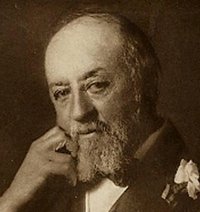 In the 1890s, Nathan Straus, co-owner of Macy's department store in New York, was already building a reputation as a philanthropist. In the winter of 1892, he distributed 1.5 million buckets of coal to impoverished New Yorkers so they could heat their homes. The following year, he organized a series of shelters that provided beds and breakfasts to the city's homeless population. In 1893, he tackled the problem of unsafe milk.
In the 1890s, Nathan Straus, co-owner of Macy's department store in New York, was already building a reputation as a philanthropist. In the winter of 1892, he distributed 1.5 million buckets of coal to impoverished New Yorkers so they could heat their homes. The following year, he organized a series of shelters that provided beds and breakfasts to the city's homeless population. In 1893, he tackled the problem of unsafe milk.Straus had been reading up on Pasteur's work and the theoretical benefits of pasteurization. He knew that nearly 10% of all children born in New York City died by the age of five -and despite all the recent improvements in milk quality, he still suspected that milk was to blame for many of the deaths. His reasoning was simple: Milk spoiled quicker in the heat of the summer, and the city's childhood mortality rate increased at the same time. He figured there had to be a connection between the two.
MILK BAR
In June 1893, Straus set up a milk-processing station in a neighborhood on East Third Street. The station pasteurized milk on the spot, then provided it at affordable prices to local families. The station also offered free medical exams for children and free hygiene advice for their mothers. Mothers who couldn't afford 2¢ for a pint or 4¢ for a quart of milk (less than the price of unpasteurized milk) could get coupons for free milk from local doctors and charities.
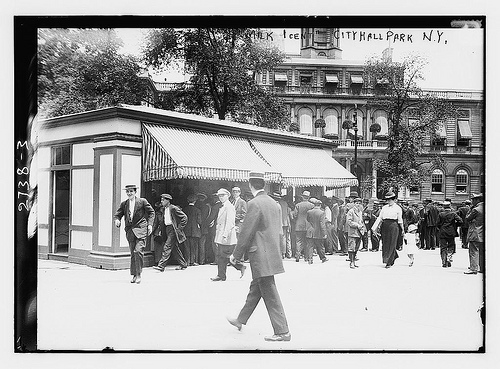 (Image credit: The Library of Congress)
(Image credit: The Library of Congress)
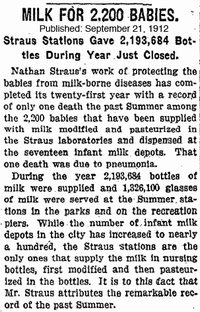 THE ORPHAN TEST
THE ORPHAN TESTThe final proof of the benefits of pasteurized milk came when Straus began providing milk to an orphanage that had seen death rates as high as 42% from tuberculosis and other milk-borne diseases. The orphanage was located on Randall's Island in the East River. All the milk it used was provided by a single herd of cows kept on the island, so it was easy to control the milk the orphans drank.
Straus started pasteurizing the orphanage's milk in 1898. Within a year, the mortality rate dropped to 28%, and continued downward in the years that followed.
AN UPHILL FIGHT
By the turn of the century, pasteurized milk stations like Straus's had been set up in Boston, Philadelphia, Chicago, and other major cities. The programs were voluntary and set up by charities. Although philanthropists were getting into the pasteurized milk business, the dairy industry was staying out of it. Citing the added cost of pasteurization, they refused to pasteurize their own milk, and blocked efforts to require it by law.
Another huge barrier was public resistance: most people were used to "pure" raw milk, and didn't understand science well enough to insist on pasteurization. The few dairies that had begun pasteurizing milk to increase shelf life and prevent spoiling did so mostly in secret, out of fear of losing sales to raw milk dairies.
Straus was instrumental in getting New York to create the post of inspector of dairy farms, making it one of the first cities in the nation to inspect the quality of milk at the source. In 1907, Straus tried to help pass a city ordinance requiring the pasteurization of all milk sold in New York. Many milk distributors, doctors, and even the city's Health Department opposed him, arguing that the health benefits of "clean raw milk" outweighed the risks. The ordinance failed.
PRESIDENTIAL SEAL OF APPROVAL
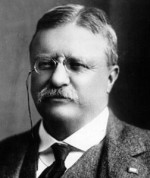 In 1907, the reform-minded president Teddy Roosevelt ordered his Public Health Service to look into the pros and cons of pasteurized milk. In 1908 the Service issued its report: Pasteurization, they found, did not affect the taste, quality, nutrition or digestibility of milk, but it did "prevent much sickness and save many lives."
In 1907, the reform-minded president Teddy Roosevelt ordered his Public Health Service to look into the pros and cons of pasteurized milk. In 1908 the Service issued its report: Pasteurization, they found, did not affect the taste, quality, nutrition or digestibility of milk, but it did "prevent much sickness and save many lives."Compulsory pasteurization was still many years away, though. A second attempt to require the pasteurization of New York City's milk supply was defeated in 1909, and a similar ordinance that had passed in Chicago in 1908 was repealed in 1910 after the courts ruled the measure interfered with free trade.
Finally in 1911, the National Commission on Milk Standards issued a report arguing that "in the case of all milk not either certified or inspected, pasteurization should be compulsory." The American Medical Association followed with similar advice a few months later. These reports and others like them ignited a groundswell of public support for compulsory pasteurization. In 1912, Chicago passed a second pasteurization ordinance; this one stuck. New York passed a similar ordinance, but milk distributors succeeded in delaying and then watering down the law.
THE FINAL STRAW
In 1913, a typhoid fever epidemic struck New York, claiming thousands of victims. By now there was proof that typhoid fever was carried by milk, and that it could be killed through pasteurization. New York City finally stopped dragging its feet. By the end of 1914, 95% of the city's milk supply was pasteurized. By 1917, nearly all of the 50 largest cities in the nation required pasteurization; the rest of the country would follow over the next several years.
The impact of pasteurized milk on public health was nothing short of astounding. In 1885 the infant mortality rate in New York City was 273 per 1,000 live births -more than 27%. By 1915 the infant mortality rate was 94 per 1,000, a drop of two-thirds.
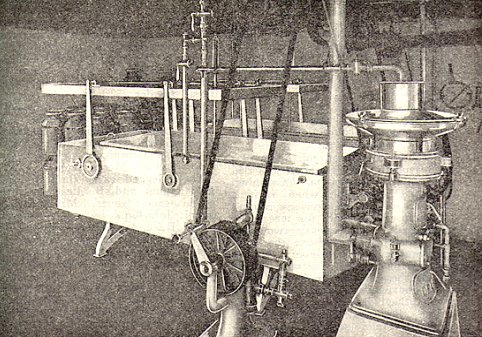
PASTEURIZATION TODAY
Today the most popular method of pasteurization is called "flash pasteurization" or "high-temperature, short-time" pasteurization (HTST). Raw milk is heated to 161° Fahrenheit and kept at that temperature for only 15 seconds, and then immediately cooled to 50° Fahrenheit.
Products like half-and-half and whipping cream, which are expected to remain refrigerated for longer periods of time, are processed by "ultra-high temperature" pasteurization at 280° Fahrenheit for two seconds.
See also: Part one of The Battle for Safe Milk: Swill Milk.
_____________________________
 Reprinted with permission from Uncle John's Giant 10th Anniversary Bathroom Reader, which comes packed with 504 pages of great stories.
Reprinted with permission from Uncle John's Giant 10th Anniversary Bathroom Reader, which comes packed with 504 pages of great stories.Since 1988, the Bathroom Reader Institute had published a series of popular books containing irresistible bits of trivia and obscure yet fascinating facts.
If you like Neatorama, you'll love the Bathroom Reader Institute's books - check 'em out!







ah, too clever.
There's a trend to buy raw milk, said to have all sorts of health benefits, but we are too far removed from the miserable past when children died in large numbers.
We take so many basics of our modern life for granted.
That being said, there isn't much in the way of actual scientific evidence that raw milk cheese makes much of a difference; often the milk is heated enough in the cheese making process to induce similar changes in the structure of the milk.
Far as I can tell, raw milk is more expensive, so more expensive cheeses use raw milk.